Admittedly, Mars has drawn more space missions than the rest of the Solar System’s planets, but why have nearly two thirds of all Mars missions failed in some way? Is the “Galactic Ghoul” or the “Mars Triangle” real? Or is it a case of technological trial-and-error? In any case, the Mars Curse has been a matter of debate for many years, but recent missions to the Red Planet haven’t only reached their destination, they are surpassing our wildest expectations. Perhaps our luck is changing…
In 1964, NASA’s Mariner 3 was launched from Cape Canaveral Air Force Station. In space, its solar panels failed to open and the batteries went flat. Now it’s orbiting the Sun, dead. In 1965, Russian controllers lost contact with Zond 2 after it lost one of its solar panels. It lifelessly floated past Mars in the August of that year, only 1,500 km away from the planet. In March and April, 1969, the twin probes in the Soviet Mars 1969 program both suffered launch failure, 1969A exploded minutes after launch and 1969B took a U-turn and crashed to earth. More recently, NASA’s Mars Climate Orbiter crashed into the Red Planet in 1999 after an embarrassing measurement unit mix-up caused the satellite to enter the atmosphere too low. On Christmas 2003, the world waited for a signal from the UK Mars lander, Beagle 2, after it separated from ESA’s Mars Express. To this day, there’s been no word.
Looking over the past 48 years of Mars exploration, it makes for sad reading. A failed mission here, a “lost” mission there, with some unknowns thrown in for good measure. It would seem that mankind’s efforts to send robots to Mars have been thwarted by bad luck and strange mysteries. Is there some kind of Red Planet Triangle (much like the Bermuda Triangle), perhaps with its corners pointing to Mars, Phobos and Deimos? Is the Galactic Ghoul really out there devouring billions of dollars-worth of hardware?
The “Galactic Ghoul” has been mentioned jokingly by NASA scientists to describe the misfortune of space missions, particularly Mars missions. Looking at the statistics of failed missions, you can’t help but think that there are some strange forces at play. During NASA’s Mars Pathfinder mission, there was a technical hitch as the airbags were deflated after the rover mission landed in 1998, prompting one of the rover scientists to mention that perhaps the Galactic Ghoul was beginning to rear its ugly head:
“The great galactic ghoul had to get us somewhere, and apparently the ghoul has decided to pick on the rover.” – Donna Shirley, JPL’s Mars program manager and Sojourner’s designer, in an interview in 1997
Well, there are plenty of answers that explain the losses of these early forays to Mars, putting the Galactic Ghoul to one side for now.
Beginning with the very first manmade objects to land on the Martian surface, Mars 2 and Mars 3, Soviet Union-built Mars lander/orbiter missions in 1971. The lander from Mars 2 is famous for being the first ever robotic explorer on the surface of Mars, but it is also infamous for making the first manmade crater on the surface of Mars. The Mars 3 lander had more luck, it was able to make a soft landing and transmit a signal back to Earth… for 20 seconds. After that, the robot was silenced.
Both landers had the first generation of Mars rovers on board; tethered to the landing craft, they would have had a range of 15 meters from the landing site. Alas, neither was used. It is thought that the Mars 3 lander was blown over by one of the worst dust storms observed on Mars.
To travel from Earth to Mars over a long seven months, separate from its orbiter, re-enter the Martian atmosphere and make a soft landing was a huge technological success in itself – only to get blown over by a dust storm is the ultimate example of “bad luck” in my books! Fortunately, both the Mars 2 and 3 orbiters completed their missions, relaying huge amounts of data back to Earth.
This isn’t the only example where “bad luck” and “Mars mission” could fall into the same sentence. In 1993, NASA’s Mars Observer was only three days away from orbital insertion around Mars when it stopped transmitting. After a very long 337 day trip from Earth it is thought that on pressurizing the fuel tanks in preparation for its approach, the orbiters propulsion system started to leak monomethyl hydrazine and helium gas. The leakage caused the craft to spin out of control, switching its electronics into “safe” mode. There was to be no further communication from Mars Observer.
Human error also has a part to play in many of the problems with getting robots to the Red Planet. Probably the most glaring, and much hyped error was made during the development of NASA’s Mars Climate Orbiter. In 1999, just before orbital insertion, a navigation error sent the satellite into an orbit 100 km lower than its intended 150 km altitude above the planet. This error was caused by one of the most expensive measurement incompatibilities in space exploration history. One of NASA’s subcontractors, Lockheed Martin, used Imperial units instead of NASA-specified metric units. This incompatibility in the design units culminated in a huge miscalculation in orbital altitude. The poor orbiter plummeted through the Martian atmosphere and burned up.
Human error is not only restricted to NASA missions. The earlier Russian Phobos 1 mission in 1988 was lost through a software error. Neglecting a programming subroutine that should never have been used during space flight was accidentally activated. The subroutine was known about before the launch of Phobos 1, but engineers decided to leave it, repairing it would require the whole computer to be upgraded. Due to the tight schedule, the spaceship was launched. Although deemed “safe”, the software was activated and the probe was sent into a spin. With no lock on the Sun to fuel its solar panels, the satellite was lost.
To date, 26 of the 43 missions to Mars (that’s a whopping 60%) have either failed or only been partially successful in the years since the first Marsnik 1 attempt by the Soviet Union in 1960. In total the USA/NASA has flown 20 missions, six were lost (70% success rate); the Soviet Union/Russian Federation flew 18, only two orbiters (Mars 2 and 3) were a success (11% success rate); the two ESA missions, Mars Express, and Rosetta (fly-by) were both a complete success; the single Japanese mission, Nozomi, in 1998 suffered complications en-route and never reached Mars; and the British lander, Beagle 2, famously went AWOL in 2003.
Despite the long list of failed missions, the vast majority of lost missions to Mars occurred during the early “pioneering” years of space exploration. Each mission failure was taken on board and used to improve the next and now we are entering an era where mission success is becoming the “norm”. NASA currently has two operational satellites around Mars, Mars Odyssey and the Mars Reconnaissance Orbiter. The European Mars Express is also in orbit.
The Mars Exploration Rovers Spirit and Opportunity continue to explore the Martian landscape as their mission keeps on getting extended.
Recent mission losses, such as the British Beagle 2, are inevitable when we look at how complex and challenging sending robotic explorers into the unknown. There will always be a degree of human error, technology failure and a decent helping of bad fortune, but we seem to be learning from our mistakes and moving forward. There definitely seems to be an improving trend toward mission success over mission failure.
Perhaps, with technological advancement and a little bit of luck, we are overcoming the Mars Curse and keeping the Galactic Ghoul at bay as we gradually gain a strong foothold on a planet we hope to colonize in the not-so-distant future…

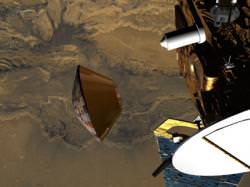

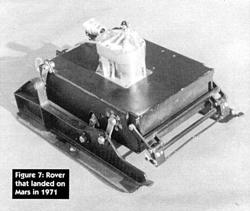
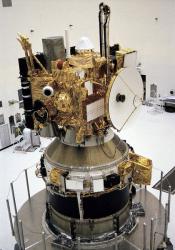
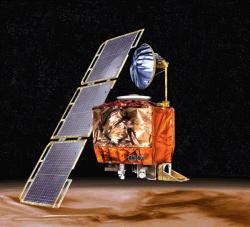
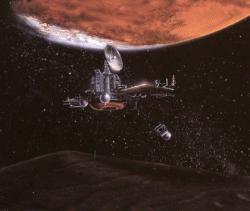
Whoa! I can still remember the Mars Polar Lander and the guys at NASA shown on TV with big letters saying “MPL PHONE HOME!”
It is those damn Aliens!
Always shooting down our 1 billion or whatever Satellites!
In before America declares war on Mars.
Unknown to Mortal Man==And any others–The USA-NOW-Has a VERY SECRET-Base on Mars–And on the MOON!!!It is now not a secret–I have told it!!Just ask anyone who works For the National Space Admistration!!
La verdad es que se han enviado más misiones espaciales a Marte que al resto del Sistema Solar, pero ¿por qué casi las dos terceras partes de todas las misiones a ese planeta fallaron por una u otra circunstancia? […] VÃa Ian O’Neill en Universe Today.
Opportunity and Spirit have wiped the carpet with the body of the ghoul.
I wish NASA would admit that all their problems are the same. For some reason the **&##%** engineers still do not know how to accurately adjust the Framastat control and adequately secure it with the two Knibbling pins! As we all know if these items are not right the trajectory demanded by the Ralston spherical equations for trajectory can not and will not match the Kirtchfiels insertion algorithms and when that happens we all know the outcome!!
I know they will never admit to this since they never wanted these simple facts know. Now you know and the secret is now out and reveled for the first time ever!!!!
Lets just hope that when Phoenix arrives in May, everything goes smooth. We wouldn’t want another sad statistic, I’m sure the staff is using proper spherical coordinate calculations but as for Kirtchfiels Algorithms, I’m pretty sure Theo full of crap.
I suspect many of the failures are related to mechanical tolerandces that are simply too tight. My experience is that tight tolerrances test OK in the lab, but go to hell in real conditions. In the case of the Mars failures, temperature extremes will grind the best fit designs to a halt if some temperature consideration is taken for granted or over looked..
..and don’t forget ‘Mariner 8’ and perhaps include the cancelled missions – the orignal ‘Voyager’ (Two enourmous probes on one Saturn V) and the cancelled manned missions…
The secret: Opportunity and Spirit are actually members of the Lovecraft Mythos — they gobbled up the Galactic Ghouls for a snack and then the Energizer Bunny, and they’re still going and going and going and . . . MuAHahahahah!
Hard on the heels of the loss of the Mars Climate Orbiter, the Mars Polar Lander went silent just prior descent and landing. A message apparently appeared later on a wall at JPL which said; “We have your satellite! If you want it back, send 10 billion in Martian money. No funny business or you will ever see it again.”
Who says the Martians have no sense of humour?
Phoenix was so named because it rose from the ashes of the Mars Polar Lander. It’s on its way at the moment and is due to land on May 25. Two months and counting …
Yeah, get it right! I mean, it’s not rocket science is it? Oh, wait…
No to mention the Capricorn I mission!
Tight mechanical tolerances lead to failure? Sorry but that statement makes NO sense at all and I don’t think Chuck knows what he’s talking about.
Either your design works at nominal or it doesn’t. If anything a LOOSE mechanical tolerance would lead to a failure.
The best fit designs are thermal vac tested well beyond the temperature extremes on Mars. I suppose we can insert the old joke, “…but it’s a dry heat” here.
In the ninth paragraph of this article the writer uses the phrase “re-enter the Martian atmosphere”. I think this mistake/oversite helps illustrate the millions of potential errors there are in just conceptualizing the massive “reach” mankind is attempting in Martian exploration.
no one has mentioned the vibration during launch of each mission or the retro-rocket stresses during mars atmosphere entry.it is also known that the changes in mars atmosphere are an unknown factor on arrival and may have been a contributing factor to malfunctions during aatmoaphere penetration.
caprricon1 mission is fiction.We may not jeer.But one thing nasa is discoverind water everyday..This appears funny ad.
watch new Telescope photos.
I’m confused. What does a false color image of a far off stellar nursery in infrared have to do with Mars?
how many satelites tried to go to mars.